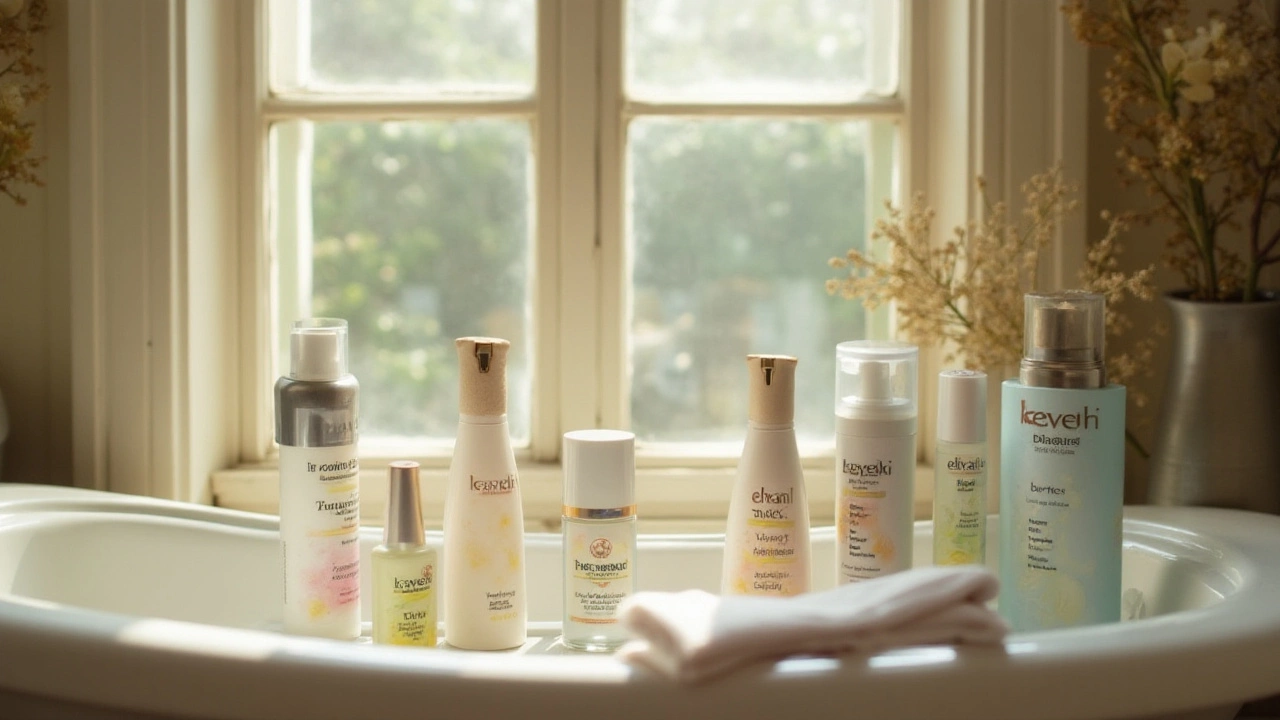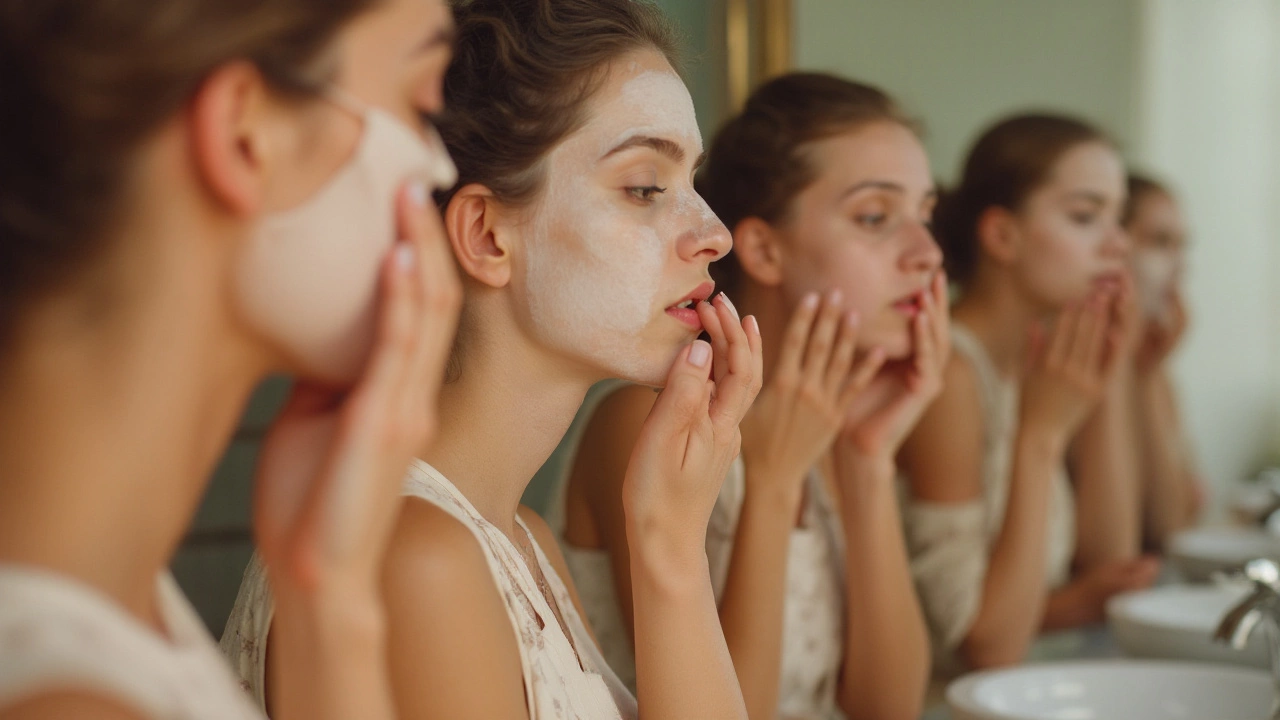The secret to radiant and healthy skin might just lie in the order of your skincare routine. Imagine your skin as a canvas, where each step in a routine serves to prepare and enhance the next. By knowing the correct sequence, you ensure that every product can work to its full potential.
Finding the right regimen starts with knowing your skin type. This awareness influences the choice of products and their application order. Each skin type—whether oily, dry, combination, or sensitive—demands specific care that aligns with its unique characteristics.
Cleansing sets the foundation, clearing away impurities and establishing a fresh base for other products. Follow with a toner, which prepares your skin to absorb the highly active ingredients in serums and treatments. Moisturizers seal in the benefits, while sunscreen offers crucial protection from harmful UV rays during the day.
By understanding and following these steps, you’ll create a routine that not only addresses specific skin concerns but also enhances your skin's health and appearance. Dive into our guide, and start crafting a skincare ritual that leaves your skin glowing.
- Understanding Skin Types
- Cleansing Fundamentals
- Toning and Its Benefits
- Powering Up with Serums
- Moisturizers: Locking in Hydration
- The Role of Sunscreen
Understanding Skin Types
To build an effective skincare routine, the first step is identifying your personal skin type. Every face is unique, but dermatologists generally categorize skin into a few primary types: normal, oily, dry, combination, and sensitive. Recognizing your skin type is crucial because it influences everything—from the textures of products you should use to the specific skincare steps each day.
Normal skin is often balanced, neither too oily nor too dry. It has a smooth texture, few imperfections, and generally requires maintenance rather than intensive care. Oily skin is characterized by enlarged pores, shiny complexion, and increased risk of acne due to excess sebum production. Yet, oily skin has its advantages, such as a natural glow and natural UV protection from the oils.
Dry skin, contrasted with oily, feels tight and often rough. It lacks the lipids necessary to maintain moisture levels, sometimes leading to flaking, redness, and irritation. Moisturizing is paramount for dry skin to restore balance and comfort. Combination skin presents the challenge of having oily areas, usually the forehead, nose, and chin—collectively called the T-zone—while other parts might be dry or normal.
Sensitive skin reacts more than usual to products and environmental changes, making it prone to irritation, redness, and itching. Understanding triggers and opting for gentle, hypoallergenic products is vital. Establishing the type is mostly about observing how your skin behaves throughout the day, in various seasons, and under different skincare products.
According to the American Academy of Dermatology, a simple test can help: wash your face with a gentle cleanser, pat it dry, and observe after 30 minutes. If your skin feels parched or discomforting, you may have dry skin. Shine on the nose and forehead might indicate combination skin, while shine all over could suggest oily skin. If your skin is calm and clear, with minimal shine, it might be normal.
"Identifying your skin type correctly is the foundation of an effective skincare regime," says Dr. Michele Green, a respected dermatologist. "Once you know what your skin needs, you can choose products that truly benefit you."
Tuning Into Seasonal Changes
Different seasons can affect skin behavior, leading some people to shift from one skin type to another. For instance, skin which is oily in the summer can turn combination or dry in the winter due to environmental changes and humidity levels. Adapting your skincare order seasonally ensures that your skin attains what it needs at any given time.
Another key factor is age. Youthful skin tends to be more resilient and typically leans towards oiliness due to active sebaceous glands. But as we age, these glands produce less oil, changing the skin's needs. Framing your skincare within this dynamic context heightens your likelihood of attaining balanced, healthy skin. Knowing your skin type allows you to curate a personal plan with intention and clarity, enhancing how products interact with your unique skin’s needs.
Cleansing Fundamentals
At the heart of any effective skincare routine lies the crucial step of cleansing. This foundational process is more than just washing your face; it involves removing makeup, dirt, oil, and impurities that accumulate throughout the day. A proper cleanse sets the stage for absorbing products that follow, ensuring their efficacy. The right cleanser depends on your skin type. Gel cleansers work well for oily skin, while cream cleansers often suit dry or sensitive types. Cleansing is not about harsh scrubbing but about gently massaging your face, allowing the cleanser to do its job without damaging the skin's protective barrier.
Mornings may require a milder cleanse to refresh your skin, removing any dead cells or sweat from overnight. In contrast, the evening cleanse is more rigorous due to the makeup and environmental pollutants gathered during the day. Using lukewarm water helps open pores, allowing the cleanser to penetrate effectively. It's often recommended to cleanse twice – a method known as double cleansing. Initially, an oil-based cleanser breaks down stubborn makeup and sunscreen, following it up with a water-based cleanser to wash away any remaining residue. This method ensures that your skin is completely free from dirt, providing a blank canvas for treatments.
Routine experts often comment on the underestimated power of cleansing. As Megan McConville, a renowned dermatologist, says,
"Cleansing is the unsung hero of skincare routines; it’s where true skin health begins."This highlights the profound impact of a thoughtful cleansing ritual. An interesting fact is that leaving residue on your skin, even from harmless substances, can lead to breakouts and dullness. Therefore, choosing a cleanser that respects your skin while delivering a thorough clean can significantly transform your skin's health over time. Remember, it's all about finding that delicate balance – effective cleansing without stripping your skin's natural oils. As you navigate through this step, it becomes apparent why cleansing remains central to any skincare order.
To further illustrate the cleansing process, here's a simple comparative table showcasing common cleanser types according to skin concern:
| Skin Concern | Recommended Cleanser Type |
|---|---|
| Oily Skin | Gel Cleanser |
| Dry Skin | Cream Cleanser |
| Sensitive Skin | Micellar Water |
| Combination Skin | Foam Cleanser |
Finding the right cleanser is a journey of trial and error, but the results are worth it. A suitable cleanser will leave your skin feeling fresh, clean, and ready to take on the day's adventures. The right cleansing routine ensures every subsequent product penetrates deeper and works more effectively, exemplifying why cleansing truly forms the basis of any successful skincare routine.

Toning and Its Benefits
Toners have long been a pivotal part of skincare routines even if they are often misunderstood. They serve as the critical middle step between cleansing and applying powerful treatments or serums. Toners not only remove any lingering traces of makeup or cleanser residue, but they also help restore the skin's natural pH balance. This balance is crucial because using a cleanser can disrupt it, leading to irritation or dryness if not corrected. By effectively priming the skin, toners ensure that the subsequent products are absorbed properly and work more effectively.
Many modern toners are formulated with active ingredients that can target specific skin issues. For instance, witch hazel and tea tree oil are common choices for those with oily skin, as they help to control sebum production and tame inflammation. On the other hand, a toner with hyaluronic acid can be a boon for dry skin, as it aids in locking in moisture. With ingredients like glycolic acid, toners can also gently exfoliate, revealing fresher and more radiant skin. These multi-functional formulas can address a myriad of concerns, from minimizing the appearance of pores to delivering antioxidants deep into the skin.
"Including a toner into your beauty regimen offers a unique advantage," says Dr. Marian Cohen, a renowned dermatologist. "It's not merely about cleansing the skin deeper, but setting the stage for the products that follow, thereby enhancing their effectiveness."
Now, selecting the right toner hinges significantly on understanding your skin type. For those with sensitive skin, look for alcohol-free options that have soothing components like chamomile or rosewater. Combination skin types may find benefit from toners that balance moisture across different areas, ensuring that drier parts are hydrated while oily zones aren't overburdened. Using a toner with natural botanicals can provide calming benefits and promote a clear complexion.
So, here's a quick tip: apply your toner with a gentle patting motion instead of rubbing, using either a cotton pad or just your clean hands. This technique helps stimulate circulation and allows the product to reach all areas of the face. Remember that toning is not just about maintenance; it is an integral step that makes sure your skincare efforts are successful. By incorporating the appropriate toner into your daily regime, you set a solid foundation for the rejuvenating and protective steps to follow.
Powering Up with Serums
Serums have become a vital part of any effective skincare routine, loved for their ability to deliver potent ingredients directly to the skin. These lightweight liquids are designed to tackle specific skin issues, from dullness and dark spots to fine lines and wrinkles. What makes serums so special is their concentrated formulas, which offer high doses of active ingredients like vitamin C, hyaluronic acid, and retinol. This ensures that the skin gets the maximum benefit from each drop.
As you reach the serum step in your skincare order, it’s important to pick a product that aligns with your specific needs. If you're focusing on brightening and reducing sun damage, a vitamin C serum is a popular choice. Meanwhile, hyaluronic acid serums are perfect for anyone dealing with dryness, as they attract moisture to the skin and help lock it in. For those concerned about signs of aging, retinol can stimulate collagen production, reducing the appearance of fine lines over time. With so many benefits, it’s no surprise that serums have become a must-have in many beauty regimens.
"The right serum can make a significant difference in your skin's health," says Dr. Jeanine Downie, a dermatologist based in New Jersey. "It's about finding the right active ingredient for your skin type and concerns."
Applying serums correctly is crucial for maximizing their efficacy. Typically, they are applied after cleansing and toning. Because they are formulated to penetrate the skin deeply, you should apply them on slightly damp skin to enhance absorption. Only a few drops are needed, gently pressed into the skin with your fingertips. Remember, patience is key with serums. While some people notice early improvements, it often takes consistent use over a few weeks to see the best results.
Let's look at some statistics to understand their popularity. According to a Nielsen survey, the global facial serums market is projected to reach $3.05 billion by 2025. This growth reflects their increasing acceptance in enhancing healthy skin. The survey also revealed that over 40% of adults aged 30-50 regularly use serums as part of their daily regime, highlighting the widespread trust in their benefits. This upward trend showcases how these power-packed products are reshaping modern skincare.

Moisturizers: Locking in Hydration
Moisturizers hold a special place in the skincare world because they perform multiple functions crucial to skin health. One of the primary roles of a moisturizer is to create a barrier that prevents external factors like pollutants and harsh weather from stripping away the skin's natural oils. This barrier doesn’t merely protect; it also traps in beneficial products applied previously, allowing serums and other treatments to deliver their magic deep within the skin’s layers. How effectively a moisturizer works often depends on when and how it's applied in your skincare routine, so timing is everything.
The field of moisturizers is vast, catering to every skin type and need imaginable. From gel-based products perfect for oily skin to thicker creams suited for the dry-skinned among us, each type serves distinctly different purposes. For instance, while lightweight gels provide quick-absorbing hydration without adding extra shine, richer creams are designed to provide intense moisture and even guard against moisture loss throughout the day. The market today is rich with options that blend traditional ingredients with modern innovations like hyaluronic acid, which can hold up to 1,000 times its weight in water, giving your skin that plump, dewy glow.
Choosing the right moisturizer involves understanding your skin's unique requirements. If your face often feels tight or appears flaky, chances are, you have dry skin in need of not just water but also oils that maintain the skin’s natural lipid barrier. Those with oily skin might mistakenly believe they can skip this step, but that often leads to an overproduction of sebum as the skin tries to compensate, turning an oil slick into a full-blown breakout. Instead, a light, non-comedogenic moisturizer can balance things out. Conversely, those with combination skin face the challenge of juggling oily and dry areas, which often means seeking products with balanced hydrating and oil-absorbing properties.
Clinical studies repeatedly highlight the importance of hydrating ingredients such as ceramides and glycerin in maintaining healthy skin. Ceramides perform by forming a protective layer to help prevent permeability. This locks moisture into your skin, which helps prevent dryness and irritation. Meanwhile, glycerin has a unique ability to penetrate through the outer layer of skin and bring in moisture from the deeper layers. This dual action is particularly important during the colder months when the air tends to sap moisture from your skin. It's during these times that we see an increase in the use of moisturizers rich in both emollients and humectants.
According to Dr. Howard Sobel, a renowned dermatologist, "Moisturizing is not just for dry skin; it’s a step everyone needs. By applying the right moisturizer, you're essentially setting your skin up for success by giving it the tools it needs to repair and rejuvenate from whatever the day throws at it."These words encapsulate the universal need for moisturizers, reminding us that they are an essential, not optional, component of a healthy skincare routine.
Given the current global skincare trends, a moisturizer is now considered not just as a product but as a ritualistic part of daily life. As consumers become more aware of what goes into their products, the demand for transparency and ethical formulations grows. More brands are listing comprehensive ingredient lists on their packaging, allowing users to make informed choices. This trend towards clean beauty underscores the idea that a moisturizer should do more than just hydrate—it should fit harmoniously into a broader lifestyle choice that prioritizes personal well-being and the planet's health.
The Role of Sunscreen
When discussing a perfect skincare routine, one cannot overlook the profound importance of sunscreen. It's the shield defending your skin against the sun's potent ultraviolet (UV) rays daily. These UV rays, divided into UVA and UVB, have distinct effects: UVA rays penetrate deeper, contributing to skin aging and wrinkles, while UVB rays can cause painful sunburns and are notorious for increasing skin cancer risk.
Regular application of sunscreen significantly reduces the likelihood of skin cancer. The Skin Cancer Foundation states that a startling 90% of skin aging is directly related to sun exposure. Imagine the impact of skipping sunscreen and what it does to your skin over time! The American Academy of Dermatology recommends opting for a broad-spectrum, water-resistant sunscreen with an SPF of 30 or more. Such sunscreen not only provides a robust barrier against harmful rays but also protects against incidental exposure during cloudy days, as up to 80% of UV rays can penetrate through clouds.
Incorporating sunscreen into your skincare regimen is straightforward, yet it's often neglected. It should be applied as the final step of your morning routine. For the best protection, apply sunscreen about 15 minutes before sun exposure, allowing it to absorb adequately. Consider this routine: cleanse, tone, apply serum, moisturize, then finish with a liberal layer of sunscreen. An ounce, roughly the amount to fill a shot glass, is considered sufficient to cover exposed areas of the body.
Moreover, sunscreen isn't just for sunny days. UV rays can reflect off snow, water, and sand, mandating year-round vigilance. Indoor exposure to UVA rays through windows also underscores the need for daily sunscreen use. Remember, serious skincare enthusiasts view sunscreen as an investment in their skin's future, protecting and preserving the results of other skincare efforts.
In an interview, Dr. Emily Weiss, renowned dermatologist and expert in skin care protection, notes,
"Sunscreen is not a seasonal choice; it's a perennial commitment to skin health, guarding against both visible and invisible damage."This insight highlights the essential role sunscreen plays in fostering youthful, healthy skin. By making it a daily habit, you are not just protecting—you're preserving.

